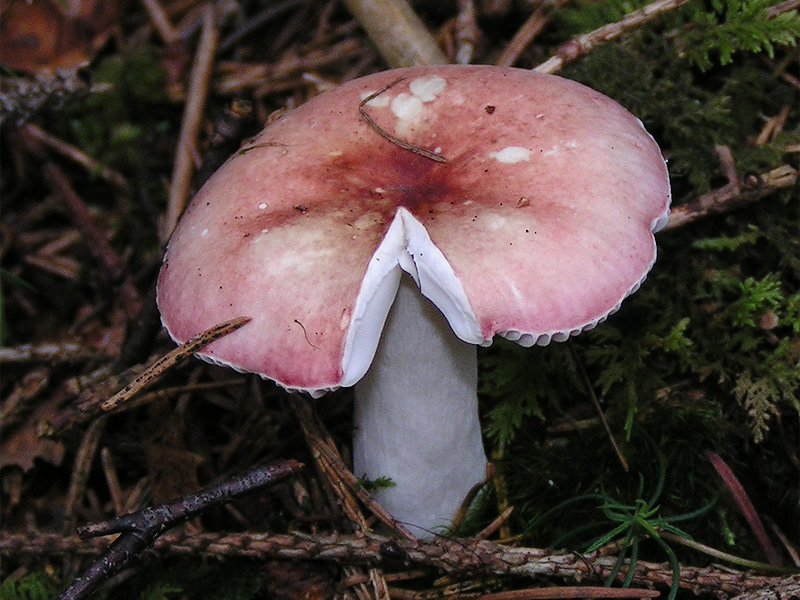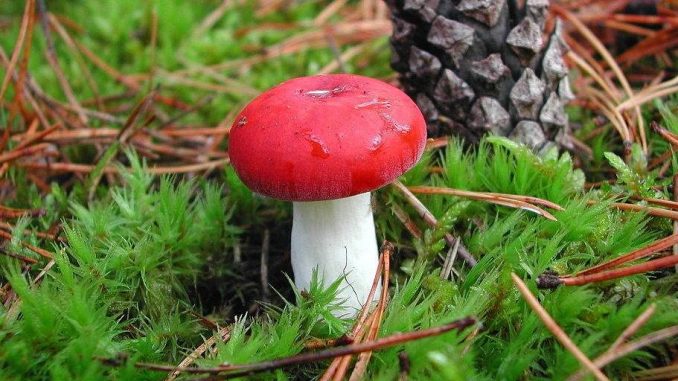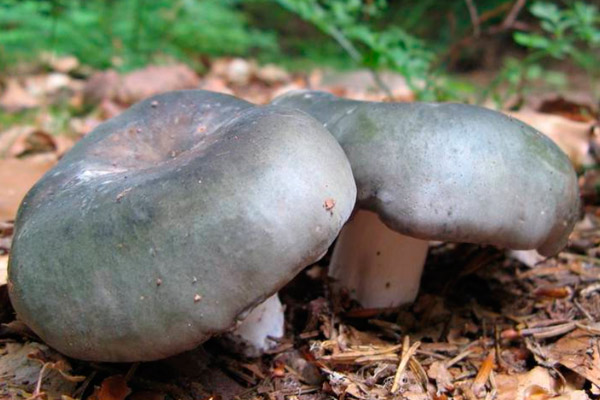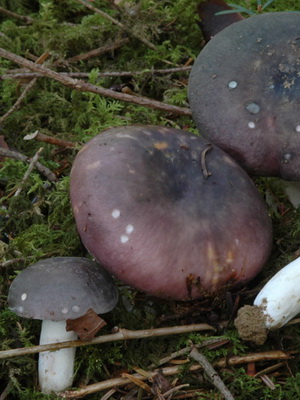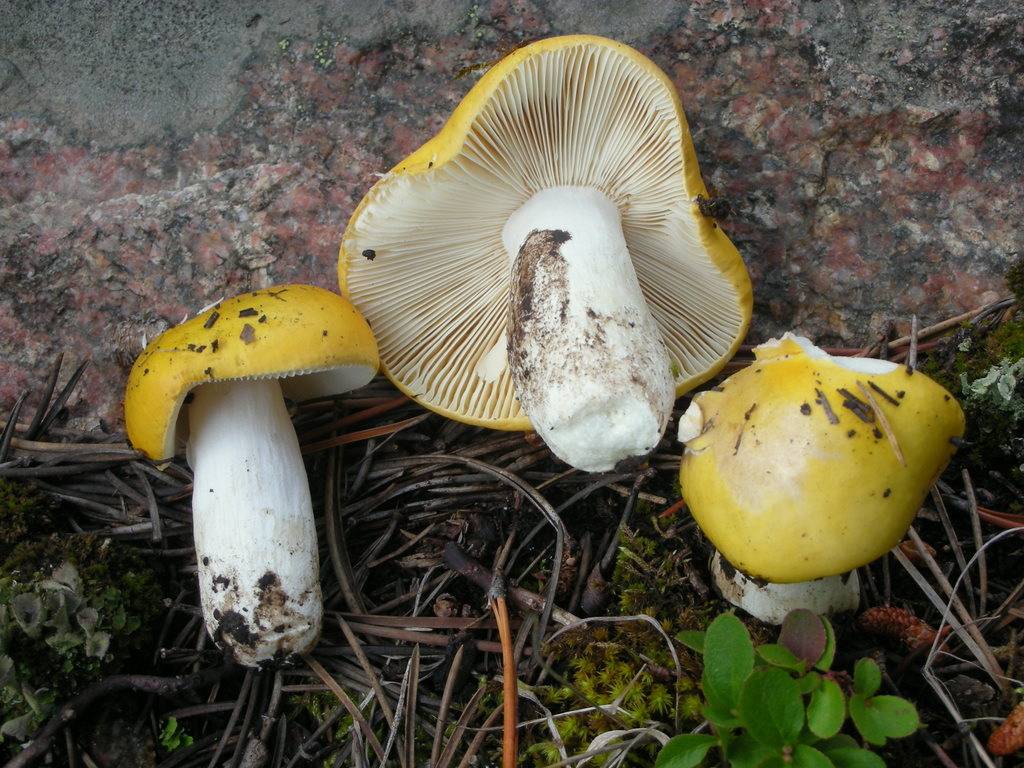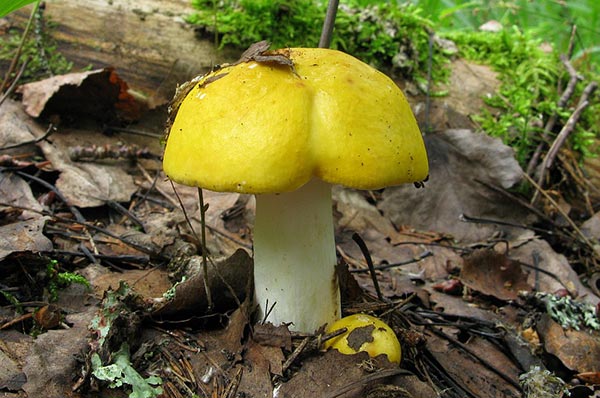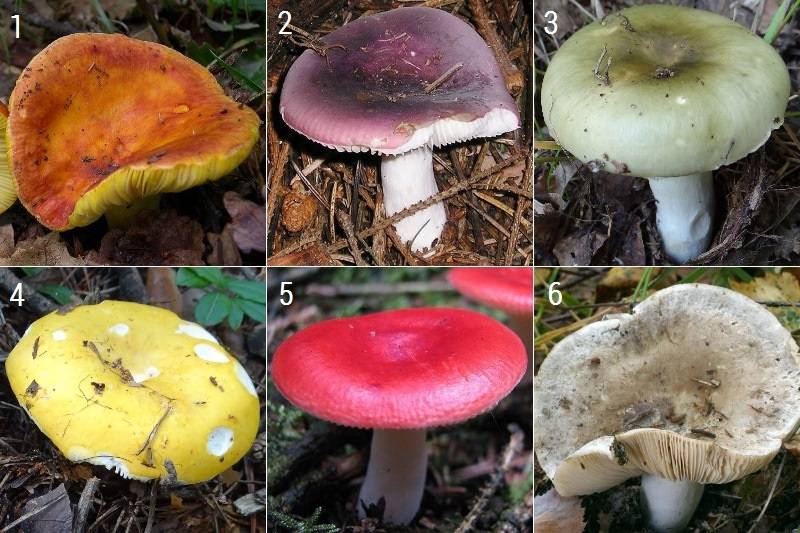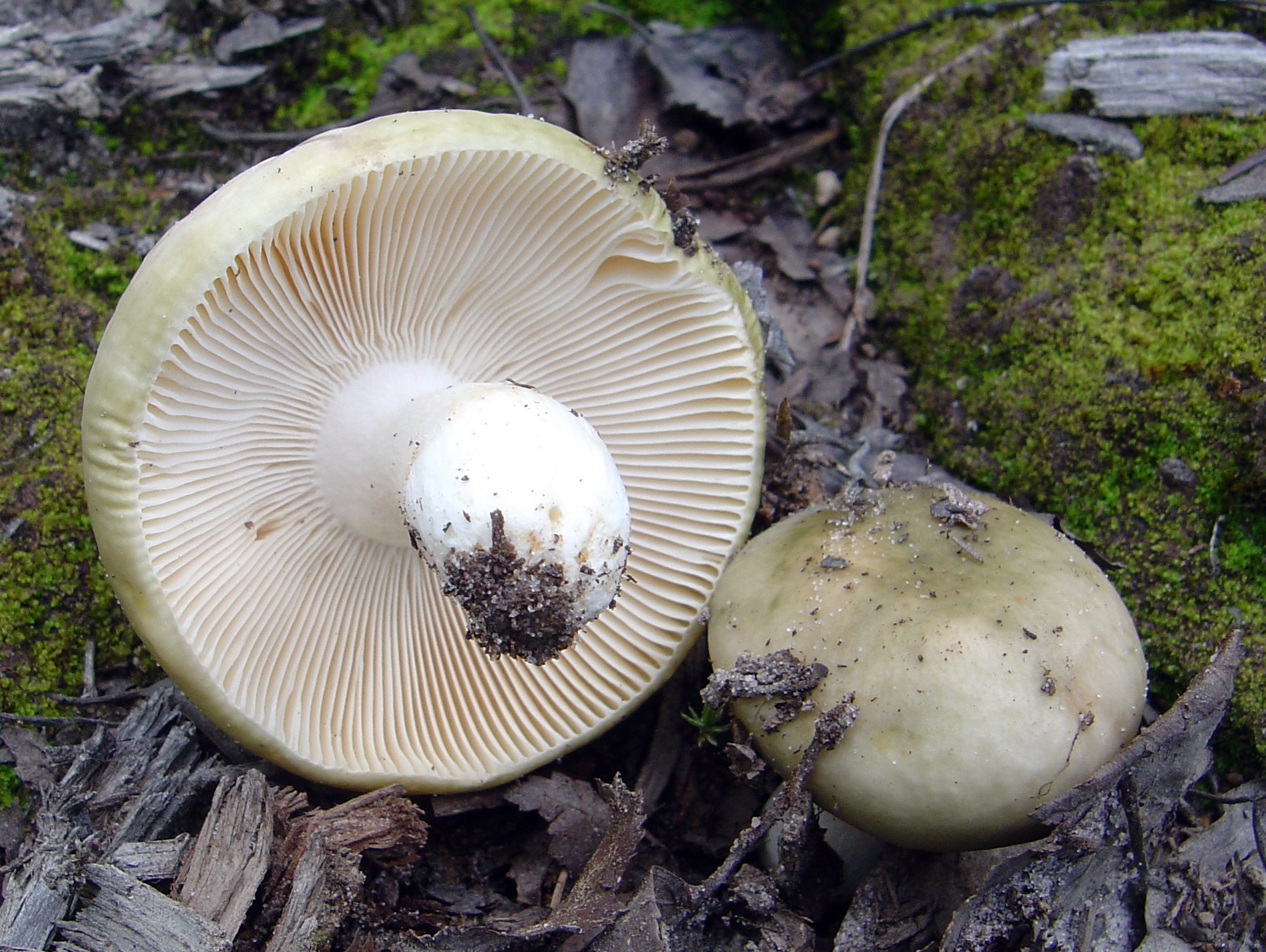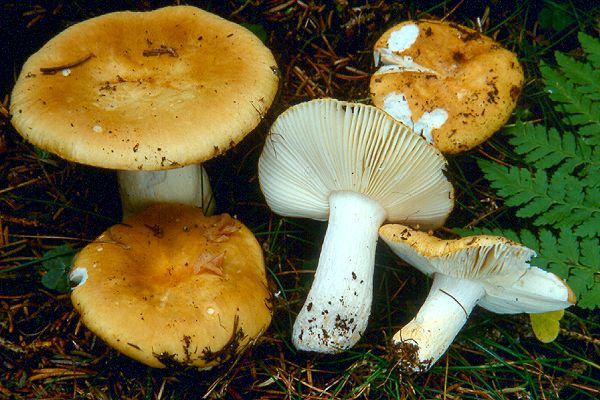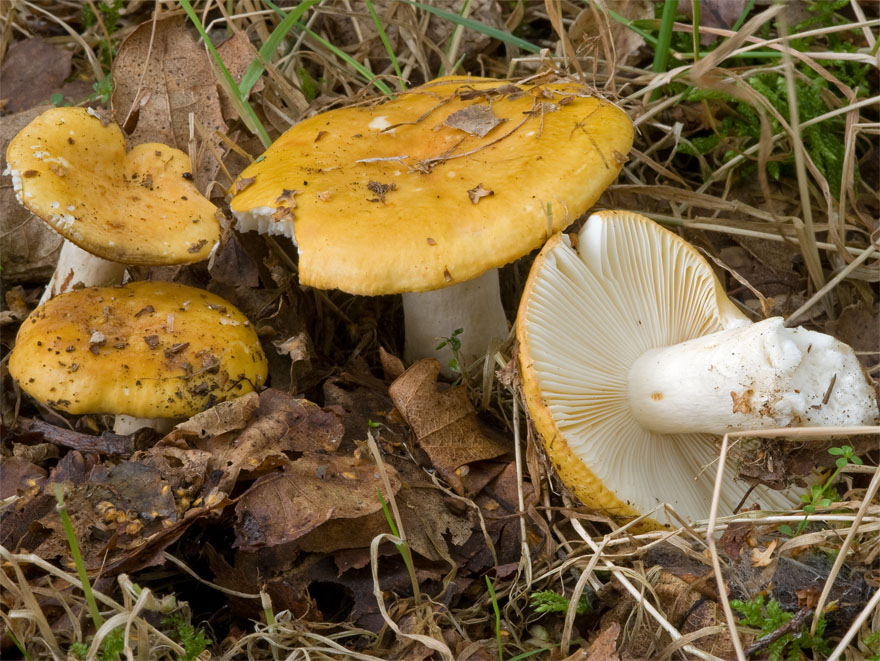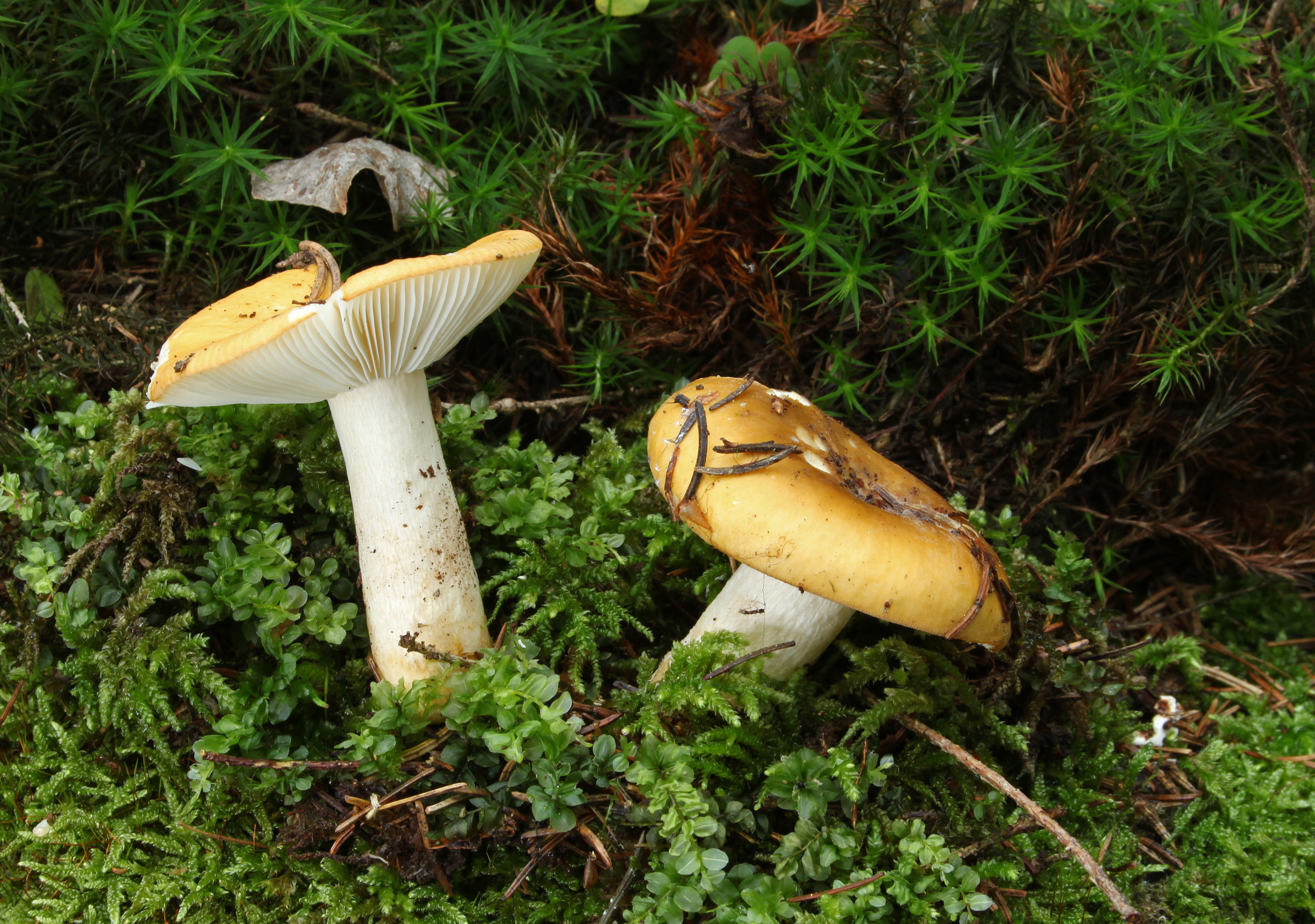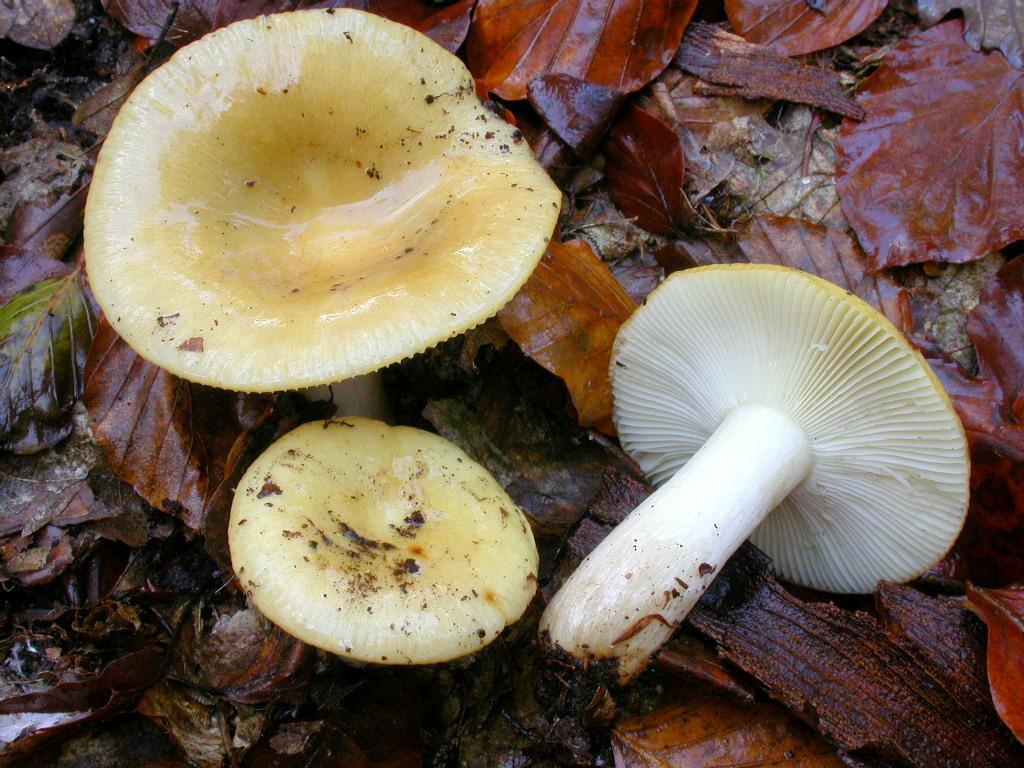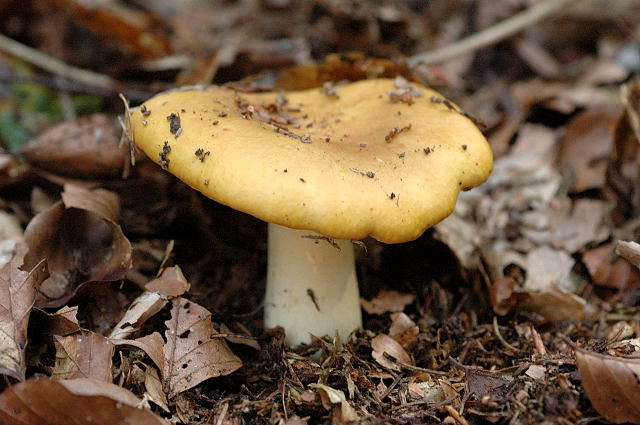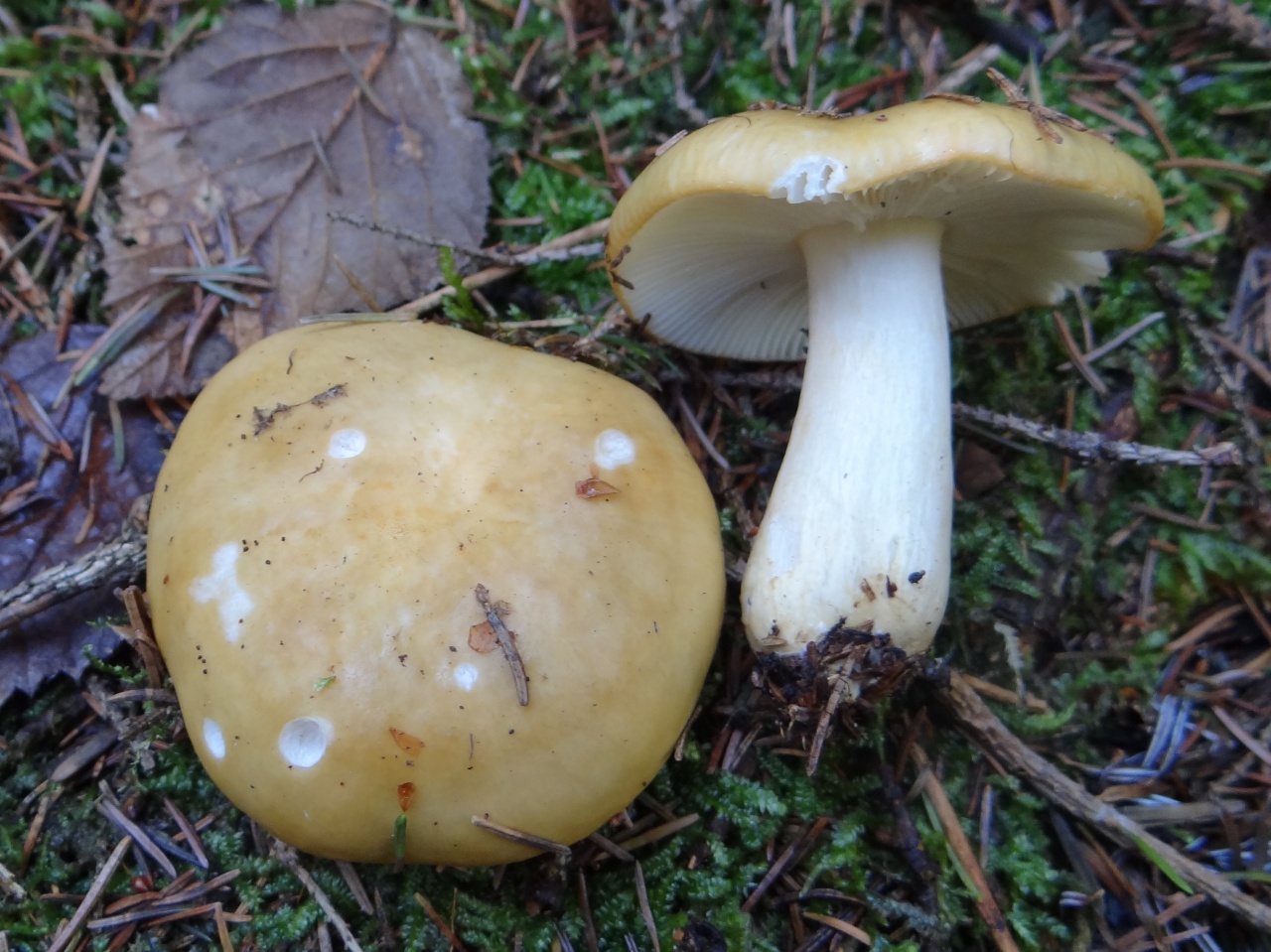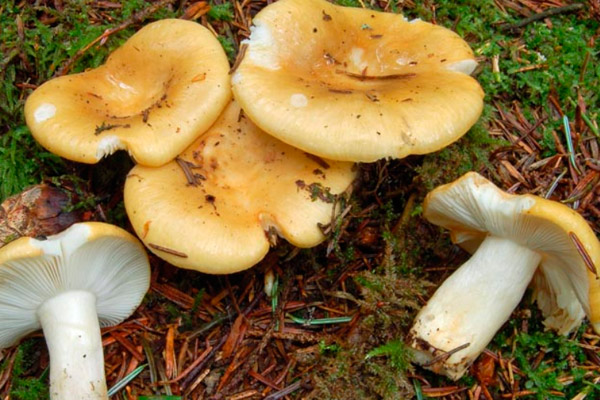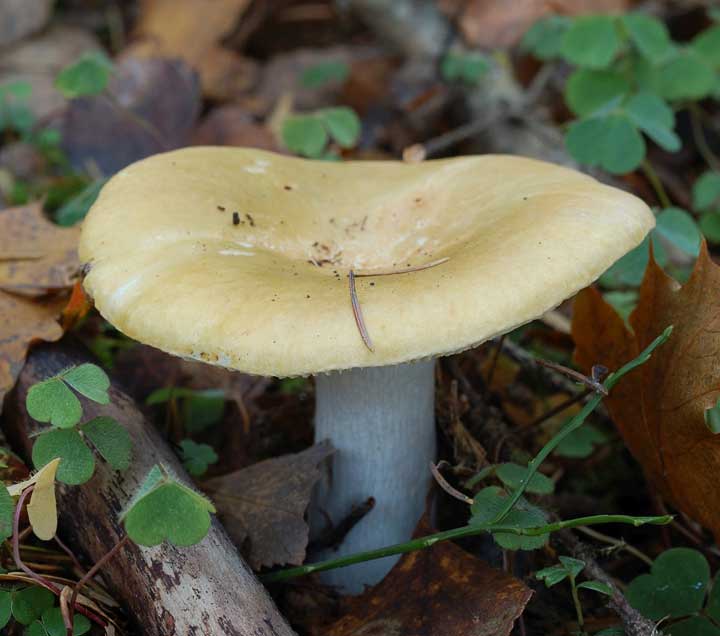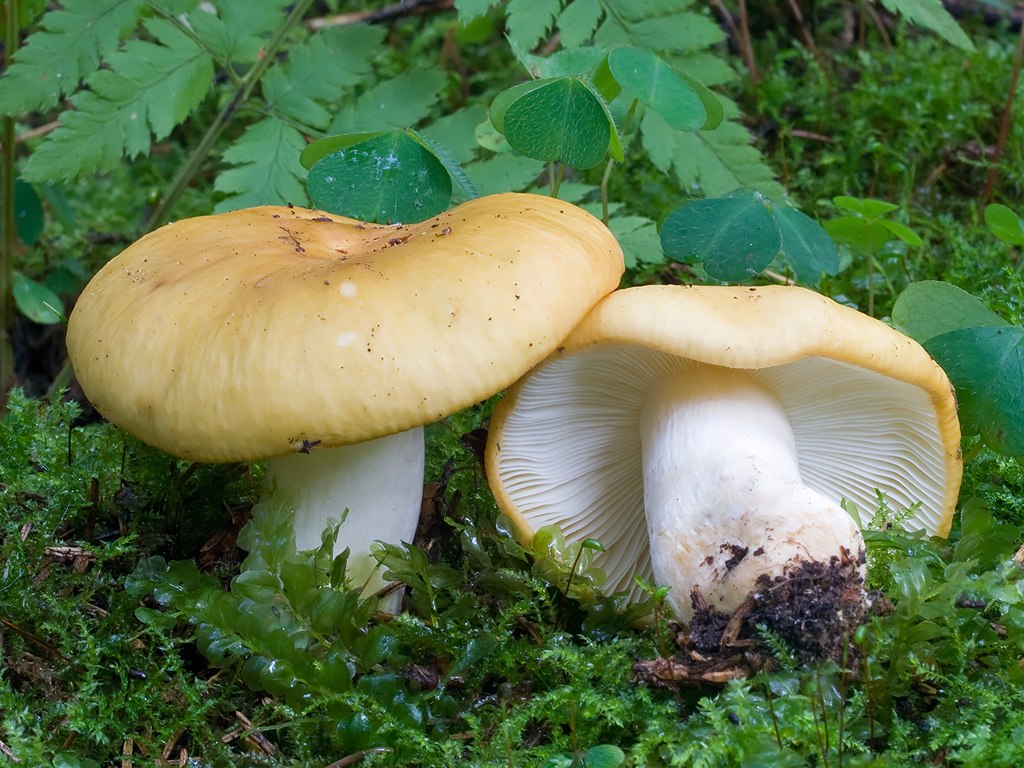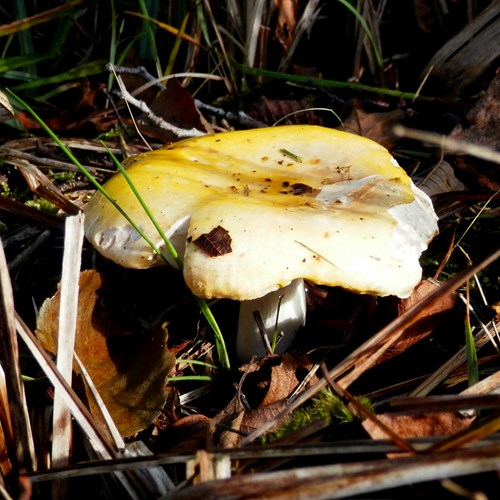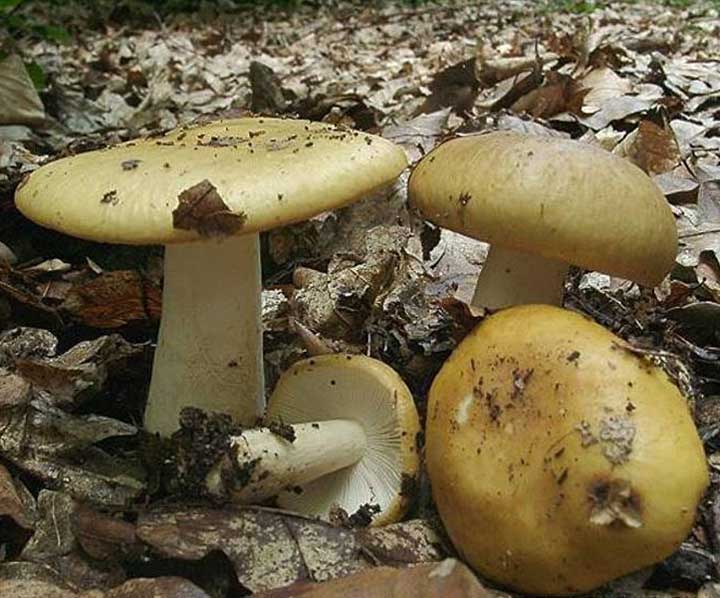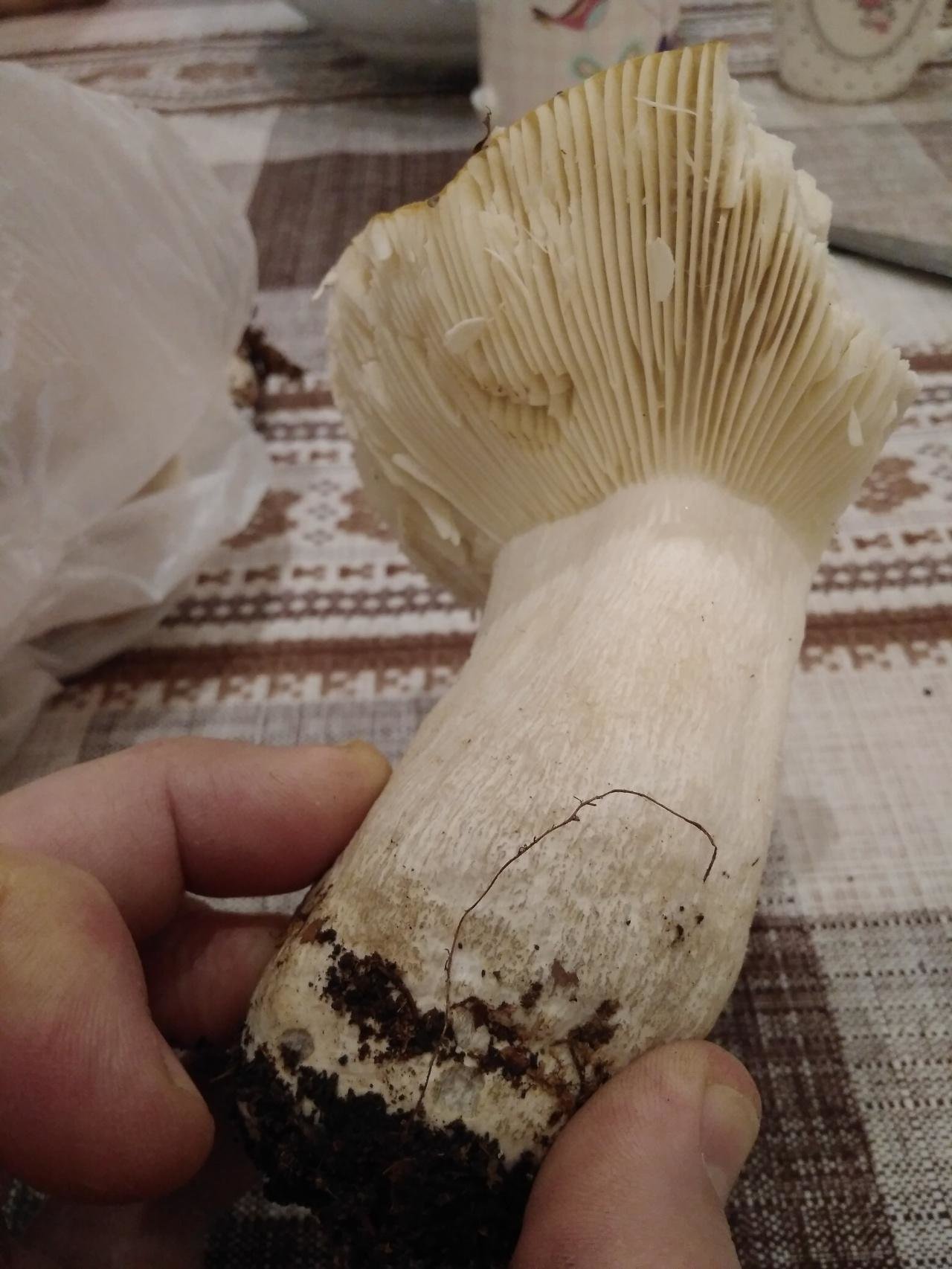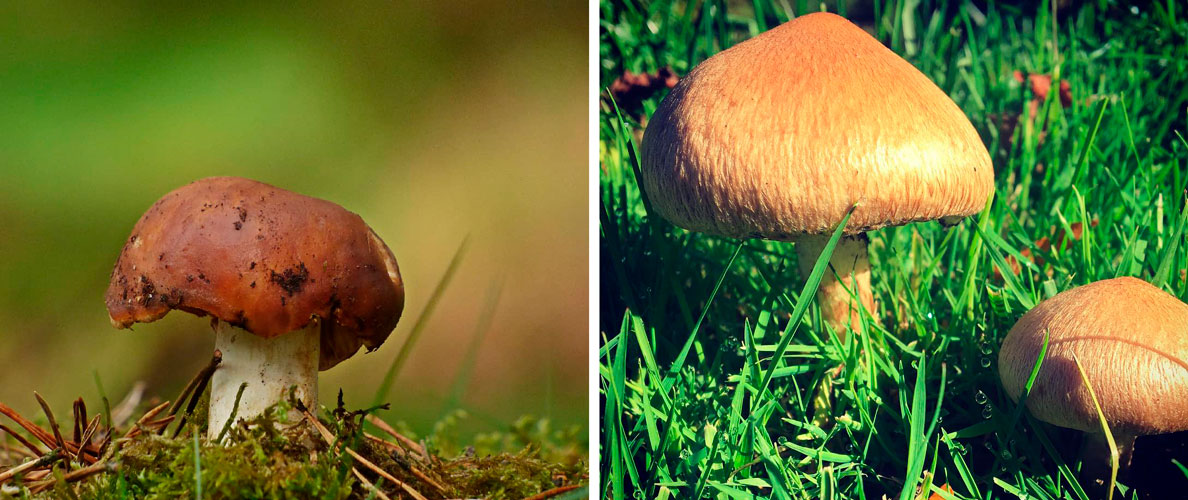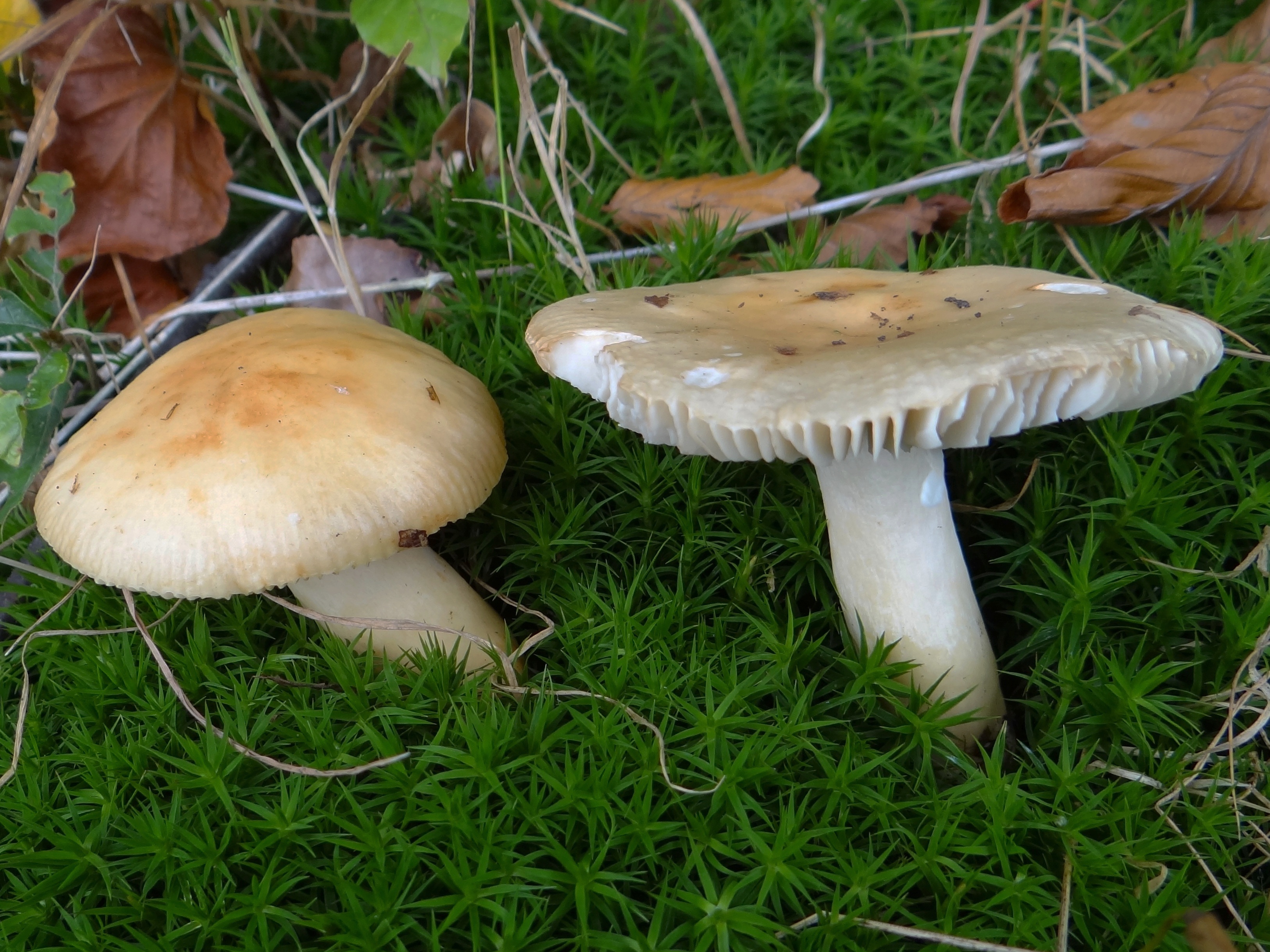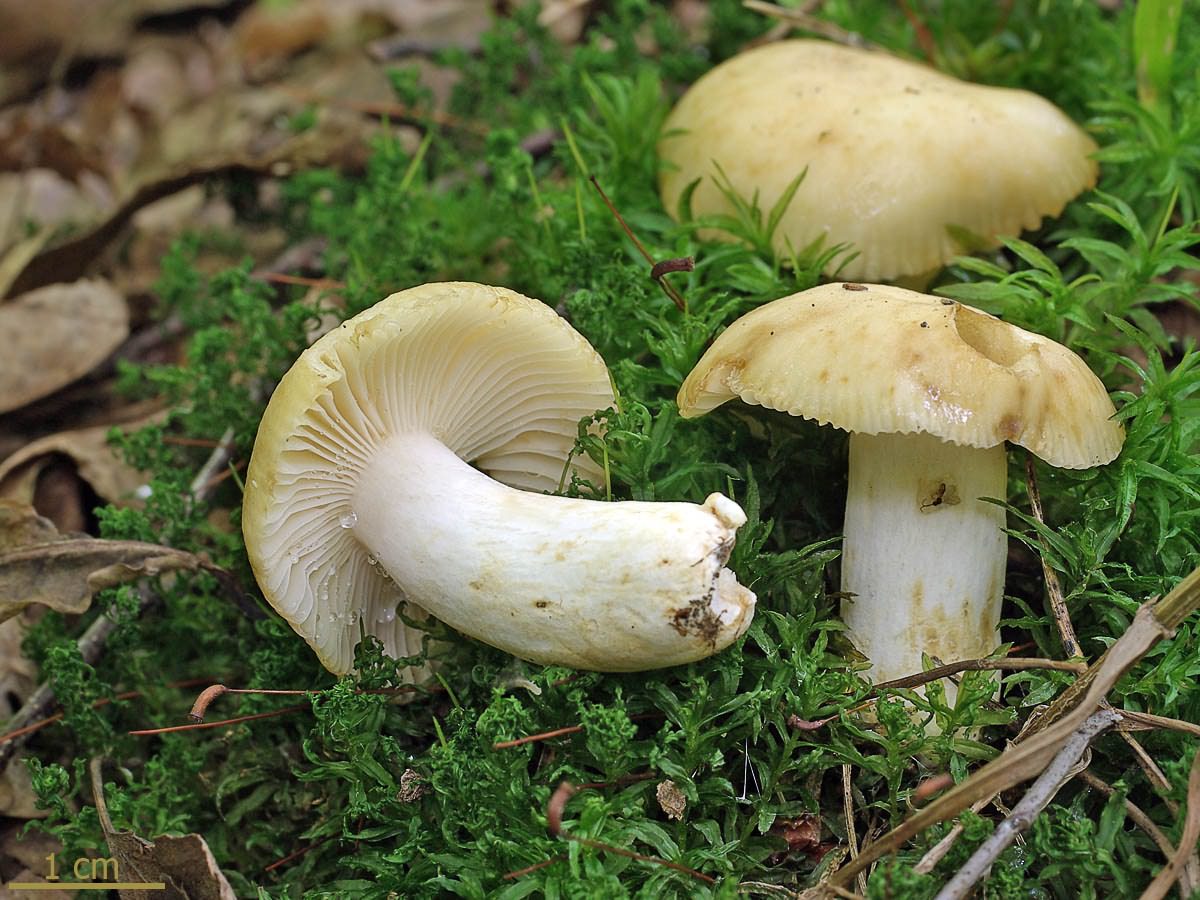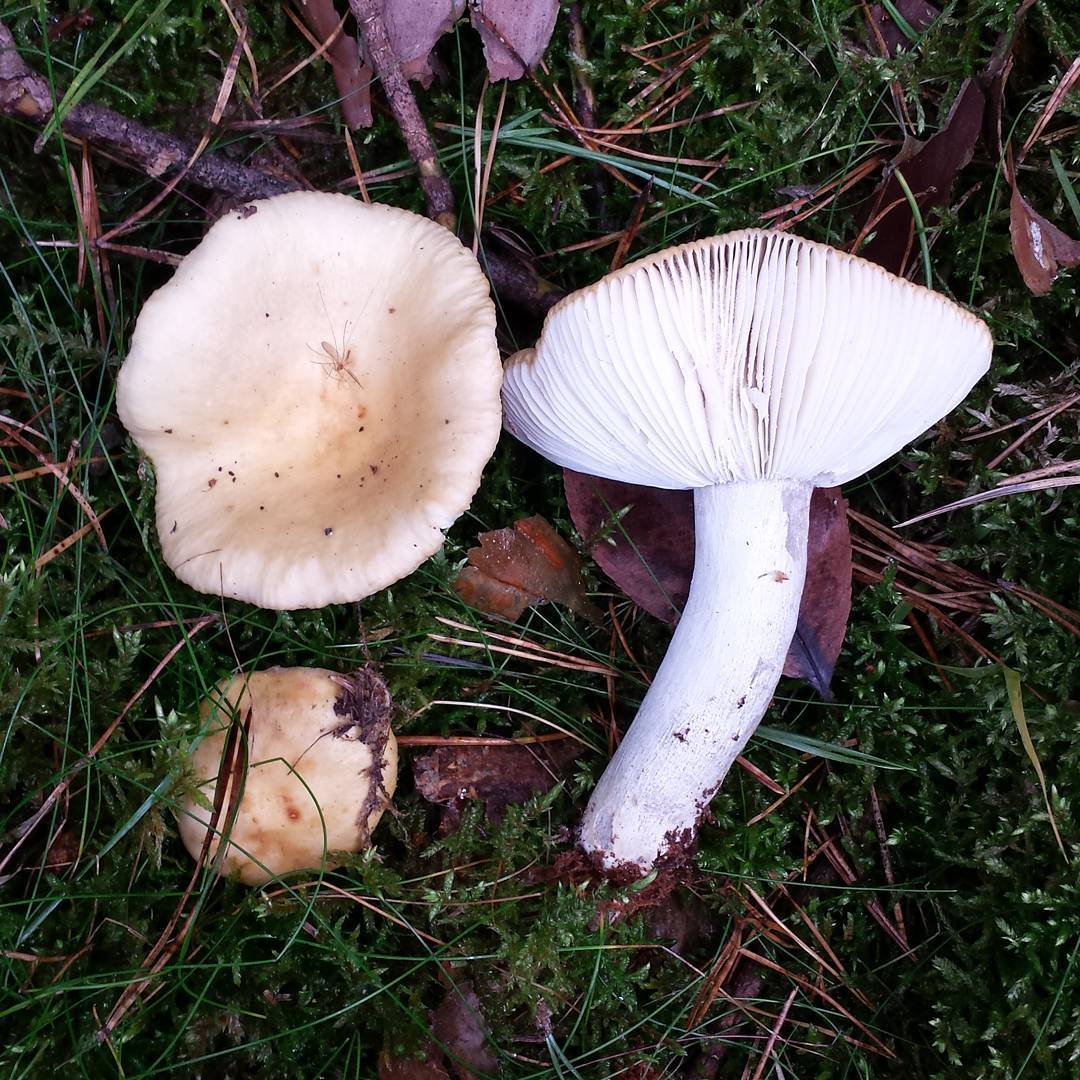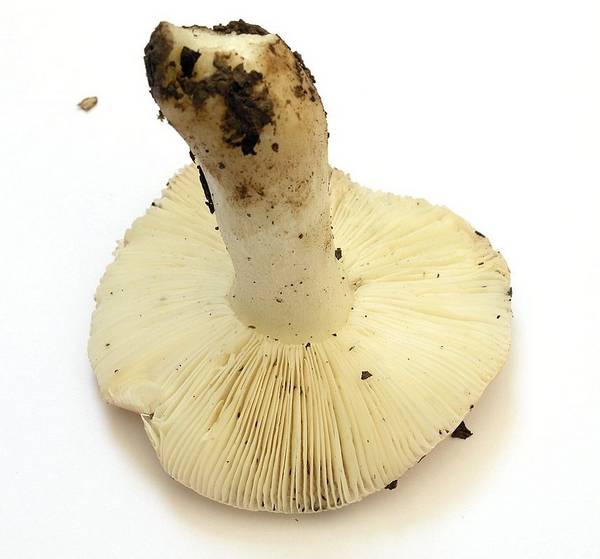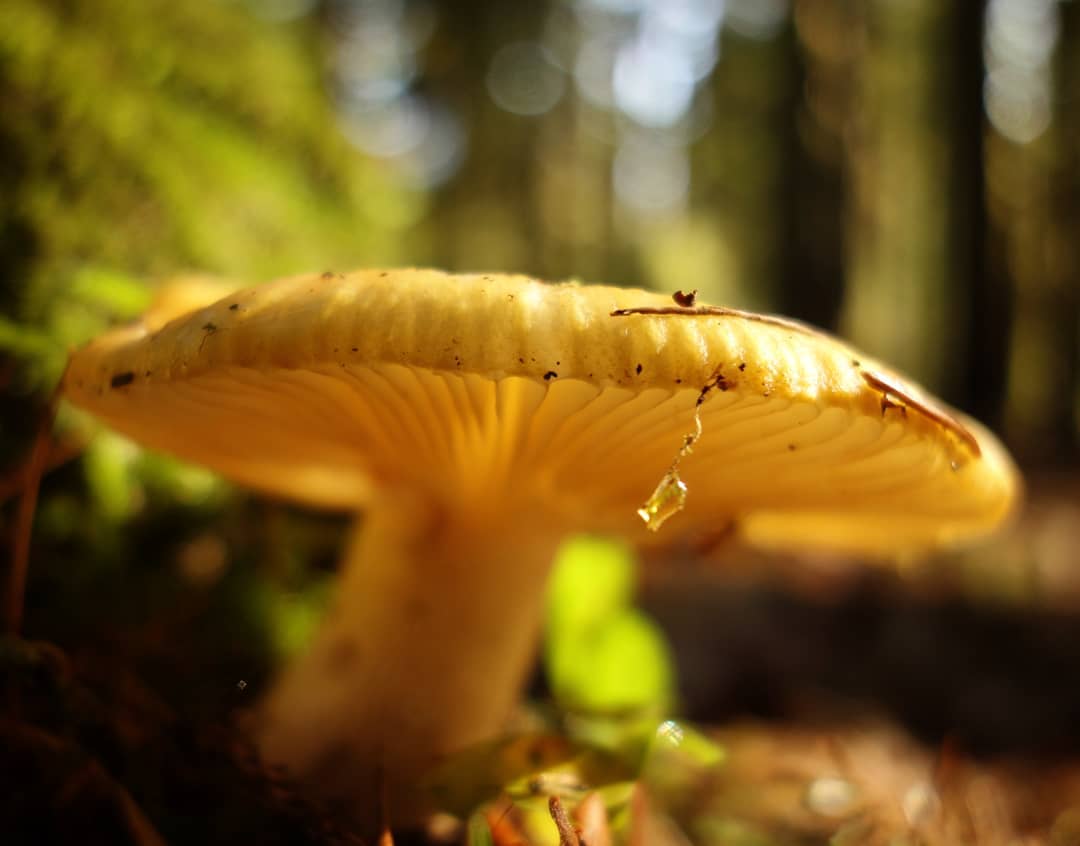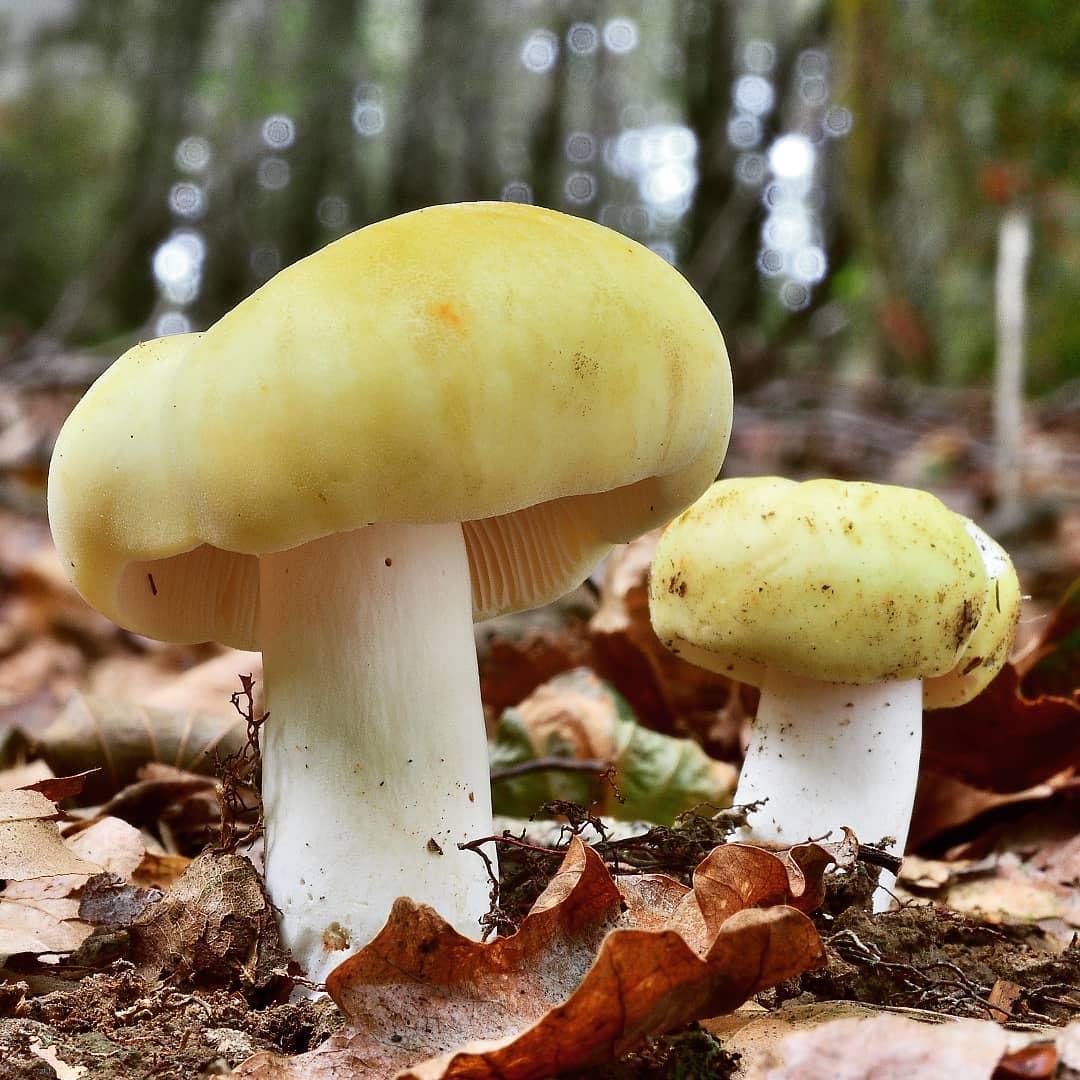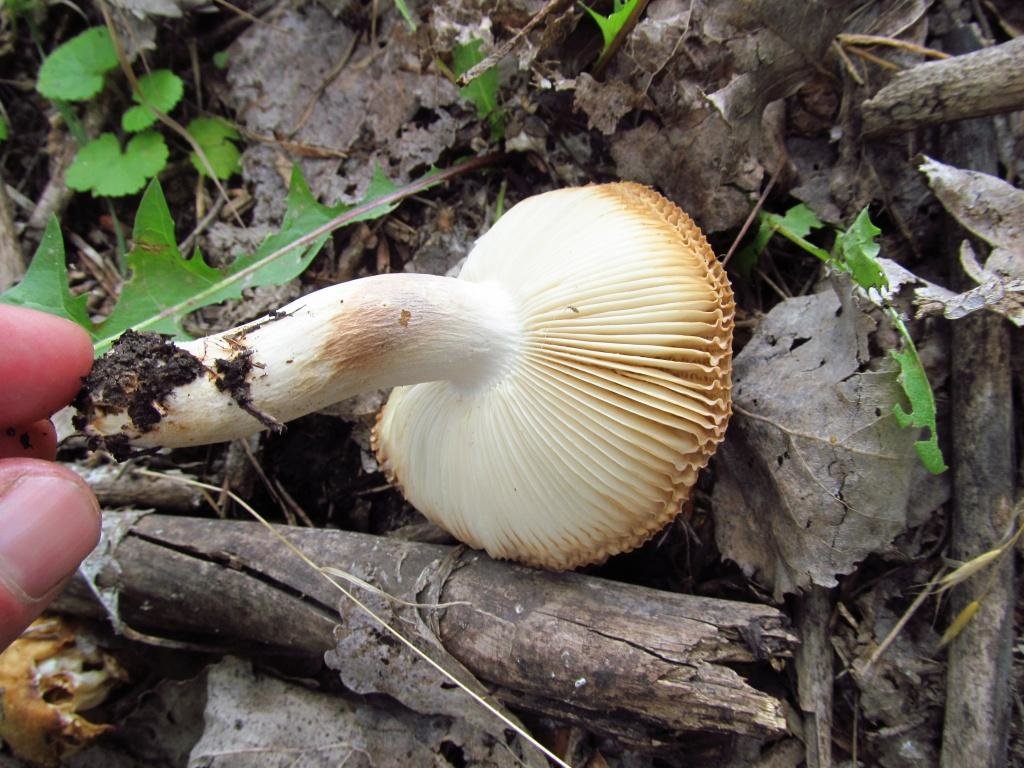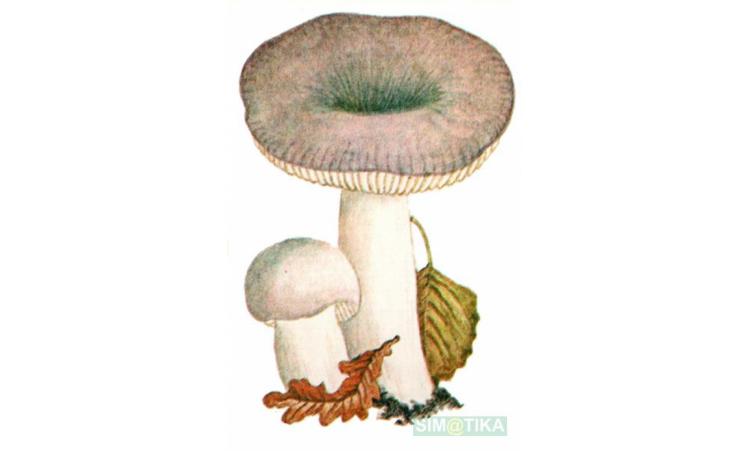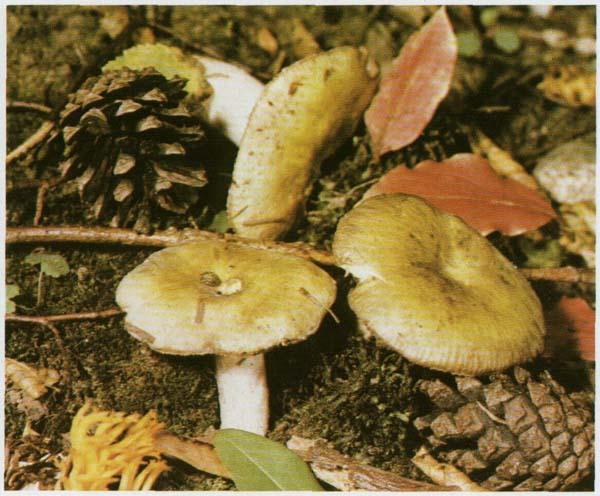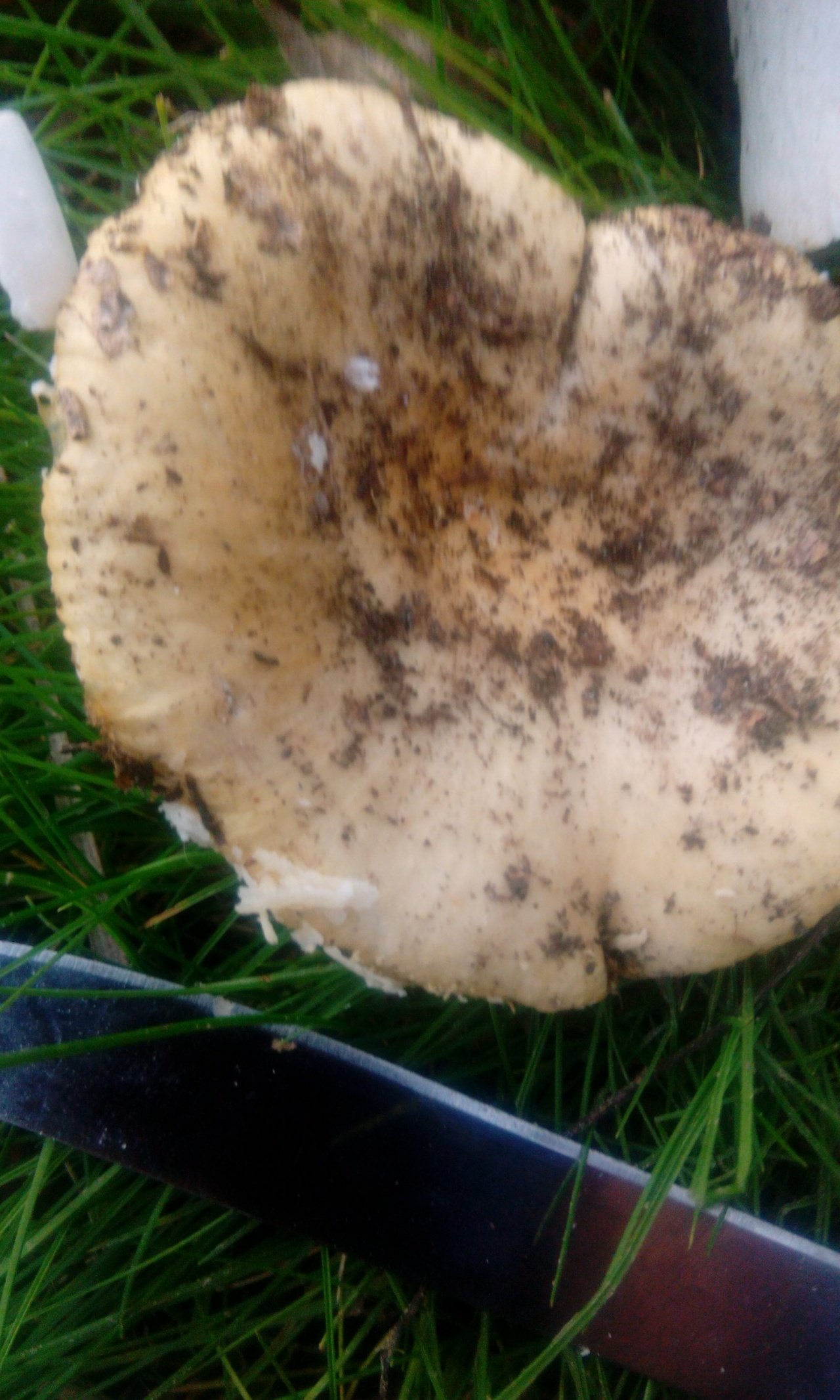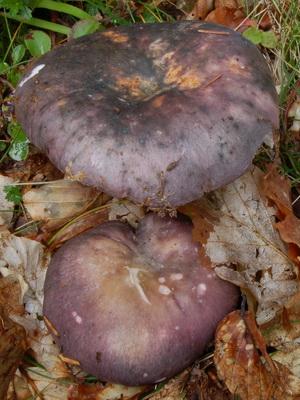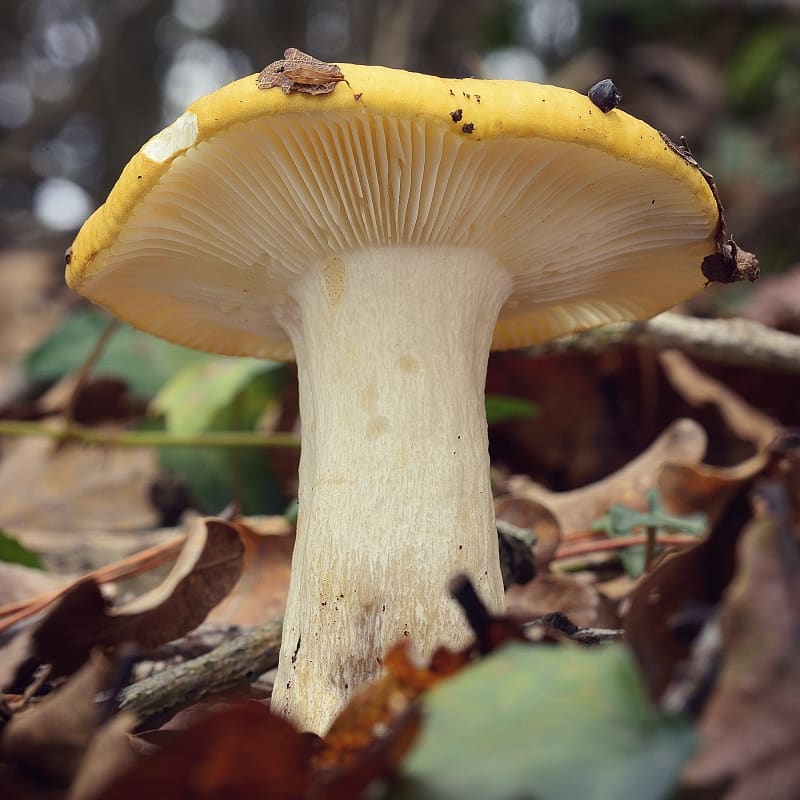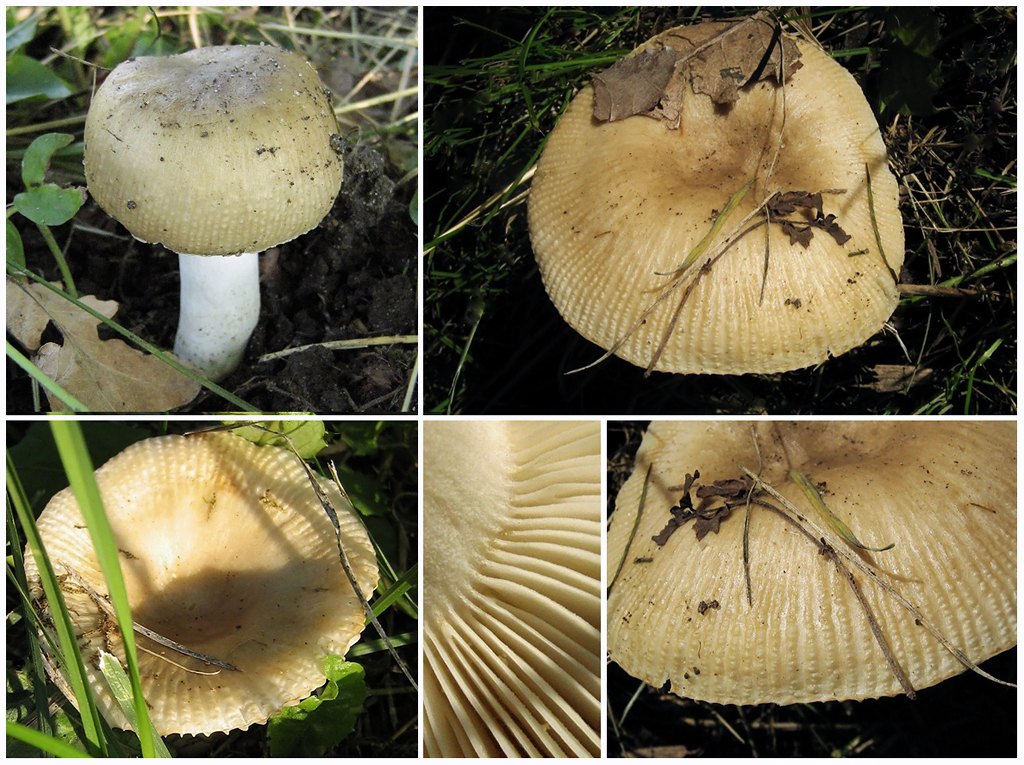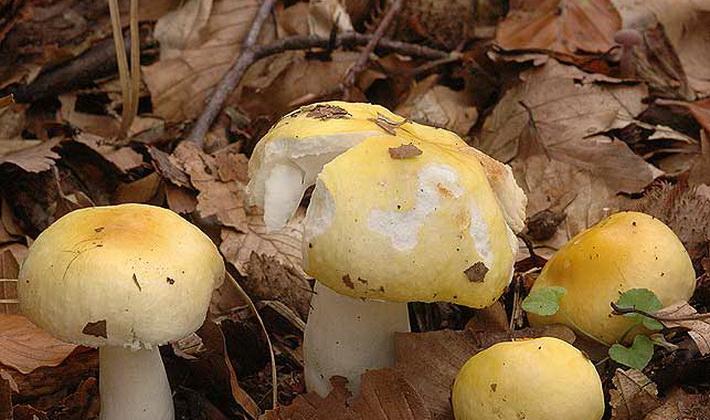Places of growth of lemon russula.
This is the most famous species of russula, these mushrooms are ubiquitous, they grow in many forests of the temperate zone. Lemon russula bear fruit from August to October. Their favorite places of growth are coniferous forests, especially spruce. They also grow in deciduous forests with good moisture levels. These mushrooms settle on the forest floor and mosses. In the southern regions of Russia, they are rare.

Evaluation of the edibility of ocher russula.
Ocher russula was assigned the third category. These are conditionally edible mushrooms, but some researchers consider them poisonous. Before eating, this type of russula must first be boiled.

Rules for the collection and processing of russula.
Russula is best harvested from August to September. It is recommended to do this early in the morning. It is advisable to cut the mushrooms with a knife so that the tip of the leg remains in the ground and the mycelium remains intact. Before you put the lemon russula in the basket, it should be cleared of forest debris.
The collected mushrooms must be processed immediately upon arrival from the forest. They are sorted, cleaned, damaged areas cut off and washed. Young, not overripe fruit bodies are best suited for processing.

The most popular way to process russula is salting. They were called russula because they can be consumed already a couple of days after salting. The nutritional value of russula is reduced due to excessive fragility.
Boil the ocher russula for about 15 minutes before cooking, as they are conditionally edible. The broth must be drained, it cannot be consumed, since harmful substances remain in it.

Related species.
Marsh russula is a fairly well-known species. Her cap has a convex shape. Its surface is dry, most often dark red, with lighter edges. The stem is pink or white. The pulp has a light fruity odor, but it has no taste. The color of the pulp is white.

Swamp russula grow in mixed forests. The fruiting period is in summer and autumn. Marsh russula is edible.
Green russula is no less well-known representative of the family than the previous two species. Its cap can be from convex to concave. The color range of the cap varies from dirty yellow to green. The surface of the cap is shiny. The pulp tastes sweet. The color of the pulp is yellow or white.
Green russula grow in mixed and deciduous forests. Fruiting occurs in summer and autumn. There is a risk of confusing this type of russula with pale toadstools.
Description of buffy russula.
At first, the shape of her cap resembles a hemisphere with curved edges, over time it becomes prostrate, and even later it becomes a little depressed. The diameter of her cap is 6-10 centimeters. The edges of the cap can be smooth or ribbed. The surface of the cap is dry, dull, and becomes a little slimy in wet weather. The color of the cap is most often yellowish-ocher color. The skin can be easily removed from the edges.

Under the cap of the lemon russula, there are thin, frequent plates. Mostly the color of the plates is white or cream, and sometimes it can be yellowish. Spore powder of ocher hue.
The leg is thin, hollow inside. Its length reaches 7 centimeters. The surface of the leg may be slightly wrinkled. The color of the leg is white, sometimes yellow.
The flesh of the ocher russula is dense, but breaks easily. The color of the pulp is whitish, and under the skin with a slight yellow tint. At the break, the flesh becomes darker. The pulp has a rather pungent taste, and it has no smell.
Preliminary preparation
How to salt russula - inexpensive, fast and tasty
The russula have one property - the pulp of these mushrooms, especially some of the species, tends to be bitter, so eating them raw will not work, and before cooking russules for food, they must undergo special training.
The rules for the preliminary preparation of these mushrooms are not at all complicated, but in order for russules to be properly salted, they cannot be neglected.
It is important to remember that each type of russula has its own taste characteristics - some require more effort in preliminary preparation, others less - everything is decided depending on the specific type. Therefore, before you start cooking mushrooms, you definitely need to have information about the features of the type of russula that you want to cook
Fruit bodies must be carefully examined and sorted out, removing rotten, overripe or overly damaged specimens.
The mushrooms must be peeled and rinsed under running water using a small brush to remove stubborn dirt.
The peel from the cap must be carefully removed - it is she, most often, the source of most of the bitterness. At the same time, be careful, as the cap of the Russula easily crumbles.
For the final elimination of bitterness from the pulp of mushrooms, the fruit bodies must be soaked in water
The period of soaking depends on the type of mushroom, and can be from 6 to 24 hours. At the same time, the water should be changed approximately every 3 hours. After soaking, the fruiting bodies must be rinsed under running water.
Too large specimens are cut into 2 - 3 parts. Small ones can be left as they are. The main thing is that all individual pieces are the same size - then they will be salted evenly.
You can use enamel and glassware, but they don't like iron russula and can turn black.
It is important, in the future, to follow the rules for storing homemade pickles. Usually they are stored in a refrigerator or cellar, where the temperature regime must be maintained from 0 to +8 degrees.
Also, do not forget about sterilizing the jars in which you will place the russula. Violation of sterilization technology is a very dangerous thing, often leading to very unpleasant consequences. Usually glass jars for pickles are sterilized twice - just before placing the product in them, and immediately after closing the lids.
There are many not at all complicated recipes for salting russula for the winter, and this article presents some of them.
Please note that some recipes use mushrooms that have already undergone special processing, while others this processing is part of the recipe.
Food russula - description, where it grows, the toxicity of the mushroom
The appearance of the mushroom
The representative of this species has a white and pink hat. There is also a dark pink appearance. The hat is about 10 centimeters in diameter. Sympathy has a rather dense structure. Does not fall through when pressed. The mushroom leg is also dense. An edible russula can be easily identified by its skin on its cap. It recedes slightly over the edges of the surface. There is a small valley in the middle part of the cap. You can also see white streaks on the hat that cover it here and there.
The plates on the inside of the cap turn yellow over time. In (then the mushroom is young, they remain white. As they grow, they have a golden hue. It is very easy to determine the age of the mushroom by them. So even quite old russula retain the density of the leg, which is why they are especially appreciated by mushroom pickers.
Growing places
Most often, this kind of fungus is found in dry places on sandy soils with a small amount of grass. It can be found in European forests and in central Russia. Yes, it does not grow in mountainous areas. Mainly only in deciduous forests. The main fraction of these mushrooms grows in the summer-autumn period. From June to September.
The edibility of the mushroom
The name of the mushroom is sometimes misleading. It is better not to taste it raw. He will be forced to undergo minimal heat treatment.
This mushroom is very healthy.It contains a lot of substances necessary for the body, among which you can carve out:
- Magnesium, calcium and phosphorus, which strengthens the mortal remains.
- Sodium and potassium, which normalizes the water-salt balance.
- Iron needed to benefit anyone from hemoglobin.
The calorie content of this mushroom is about 19 kcal. This is a rather nutritious mushroom, it contains dietary fiber, useful elixir of life and active biological substances. Due to its low calorie content, it is used to treat and cleanse the gastrointestinal tract. With regular use, the thing of the heart is restored and blood pressure normalizes.
But most mushroom pickers are in a hurry to take this mushroom into their baskets. All because of the brittle pulp. Therefore, it is difficult to convey them in the future to the house as a whole.
Also another property of russula is its vocation to curdle milk. Therefore, it is sometimes used in cheese making. So far, one component of russula is very useful for the body. It contains lecithin, one or the other prevents the formation of cholesterol.
How to cook russula
Some people in this family have a slightly bitter taste. This does not apply only to those that have a pink, egg or greenish tint. But it is better to soak the food russula in water in advance, then, without fear of it, you can eat it well. It can also be dried. It is a non-poisonous mushroom, but it should learn minimal processing.
It got its name due to the fact that it takes a little time in all respects to prepare it. Just 5-7 minutes is enough so that it only remains to be eaten. It can be consumed fried, boiled and salted. Yes, it is also used as a blank for the winter.
Correct waste
You can store russula in the refrigerator for 5 days. But to be this you need to know that they have unimportant (= unimportant) contact with each other, otherwise they will quickly begin to deteriorate. You can save by wrapping each mushroom in a damp cloth. To preserve the mushrooms, keep them for a longer period, they will have to be dried or tightened. Dried mushrooms are stored in a tightly closed dark container in a cool dry place. Frozen goblin meat can be stored for 8-10 months, but the temperature should not be higher than -18 degrees.
On the right not to be mistaken with a choice
The russula is dangerous because, exactly without knowing whether the mushroom is edible or not, it fell into a rake, mushroom pickers begin to eat them. But this should not be done. Because this can lead to unpleasant consequences. For example, this type of goblin meat is known as russula vomit. He fully lives up to his nasty nomination. This mushroom has a brighter reddish cap. After the use of such a mushroom, vomiting may begin, the mucous membranes will be irritated.
Safe russules are pinkish or slightly yellowish in color. They have a slightly sweet taste. Such unprofitable russula will harm the body even in its raw form, but it is easier not to risk it. False russula are distinguished by their smell. They exude an antipathy, even pungent odor. The russula has a weak mushroom food, glimpses of a nutty aroma.
Russula is a nutritious and very tasty goblin meat, but it is necessary to correctly distinguish it among inedible species, after which the body will receive only benefits.
Description and places of distribution of ocher russula
The russula family in our forests is represented for the most part by edible species. However, some varieties have conflicting nutritional characteristics. These include buffy russula.
Description
Buffy russula (Russula ochroleuca) most often belongs to the category of inedible, but some experts consider it conditionally edible. Synonymous names are lemon russula, pale ocher russula, as well as pale yellow, ocher yellow, ocher yellow and ocher white.
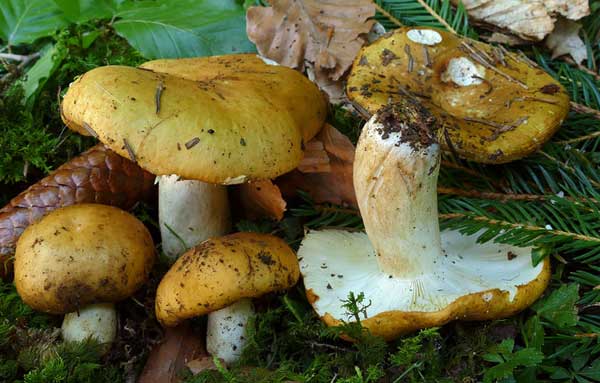
The species has the following features:
- the cap is painted in an ocher-yellow color of varying intensity, sometimes with greenish tints, in the center it is darker, closer to brown. In the early stages of development, it is convex, hemispherical with curved edges, gradually opening up to flat, depressed in the center. The skin is matte, dry, can be easily removed in long strips, with high humidity it becomes somewhat mucous. The diameter of the cap is from 5 to 12 cm;
- White and light creamy plates are relatively frequent, narrowly adherent;
- spores are white;
- the cylindrical stalk in the early stages of growth is white, then grayish-yellow. Length from 3 to 9 cm, diameter - from 1 to 2.5 cm;
- the flesh is whitish, fragile, odorless, has a more or less pronounced peppery taste.
Distribution and fruiting period
The ocher russula grows in groups and singly in European deciduous groves, in mixed and coniferous, especially pine, woodlands. The species is widespread and common in the middle lane. Fruiting bodies appear from the end of July and can be found before the first frost (October or November).
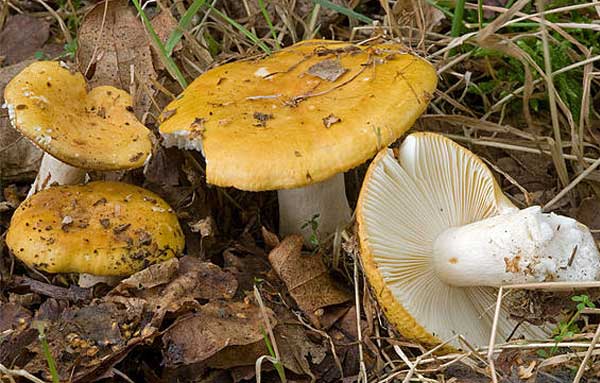
Similar species
3 relatives look like an ocher russula:
- yellow (Russula claroflava) - an edible species with a bright yellow cap and white flesh, gradually turning black at the break and cut;
- brown (Russulamustelina), growing mainly in mountainous areas. Her hat is brownish in color, fading to beige. The mushroom is edible;
- bilious (Russulafellea), inedible due to a very strong pungent-bitter taste. These mushrooms often have a flattened tubercle in the center of the cap, the flesh smells like geranium.
Edibility
The mediocre taste and peppery taste, usually inherent in ocher russula, give reason to consider this mushroom inedible. At the same time, some mushroom pickers collect it as conditionally edible and remove bitterness by boiling the fruit bodies in several waters. Probably, the severity of the unpleasant aftertaste depends on the area in which the mushroom is harvested. In addition, ocher russula can be easily confused with bilious, which will surely ruin all the pleasure of mushroom cooking.
The ocher russula is a mushroom with a dubious reputation for taste. Most often, this species is classified as inedible and well-informed mushroom pickers are better off collecting more reliable, certainly edible varieties of russula.
Edible russula greenish and its photo
Category: edible.
Cap of a greenish russula (Russula virescens) (diameter 5-16 cm): green, but can be yellowish or bluish. In young mushrooms it is hemisphere-shaped, in older mushrooms it is spread. Fleshy, often cracked. The skin is very thick, it is difficult to separate from the pulp.
Leg (height 4-12 cm): usually white.
If you look closely at the photo of the greenish russula, you can see small scales at the very base of the leg.
Plates: frequent, white or light cream color.
Flesh: firm and whitish, slightly pungent in taste.
Doubles: the greenish representatives of the pale toadstool (Amanita phalloides), differ from the russula in that they have a ring on the leg and a volva.
This edible russula grows from mid-July to early October in temperate countries.
Where can you find it: in deciduous and mixed forests, most often in the vicinity of oaks and birches.
Eating: one of the most delicious russula, which can be eaten after 15 minutes of boiling, pickled, salted or dried.
Application in traditional medicine: not applicable.
Other names: russula scaly.
What are edible russula: food
Category: edible.
Hat for food russula (Russula vesca) (diameter 4-12 cm): matte, pink-red, brick or red-brown. In young mushrooms, it is hemispherical, becoming almost flat over time. Slightly sticky to the touch in wet weather. The edges are bent towards the inner side, sometimes wavy and ribbed. The skin does not completely cover the flesh, exposing the plates at the edges, it is easily removed only from the edges.
Leg (height 3-7 cm): white, yellow or pink-rusty, very short, cylindrical. Dense in young mushrooms, hollow in older ones.
The plates of this species of russula mushrooms are very frequent, white or yellowish, sometimes with rusty spots.
Pay attention to the photo of food russula: its pulp is fleshy and dense, white, brittle. No pronounced odor
Doubles: russula relatives, but only the food peel does not cover the plates.
When it grows: from mid-July to late September in Europe.
Where to find it: In all types of forests, especially in the vicinity of birches and oaks.
Eating: delicious mushroom. It is used in any form, provided that it is boiled for 15 minutes.
Application in traditional medicine: not applicable.
Other names: edible russula.
External description of birch russula.
The fruit body of the birch russula is fleshy, it consists of a leg and a cap. The cap is very fleshy and brittle at the same time. Its diameter is 2-5 centimeters. In immature fruiting bodies, the edges of the caps are wavy. As they grow older, the cap becomes slightly depressed. Its color can be different - from copper to reddish, but most often it is pink-lilac with a yellowish tinge. In high humidity, the cap becomes spotty and its color becomes creamy. The top skin of the cap is easily removed.
The flesh of the birch russula is very fragile. The color of the pulp is white. The smell of the pulp is weak, and the taste is pungent. The hymenophore of the birch russula is lamellar. It is formed by thin and sparse plates. The structure of the plate is brittle. They grow together a little with the surface of the leg. The edges of the plates are uneven. The color of the plates is white. Spore white powder. Spores are ovoid.
The legs of birch russula at a young age are very dense, and after rain they become very brittle, as they become soaked. Most often, the thickness of the leg is the same, but sometimes the upper part of it is thinner. The color of the leg is yellowish or whitish. The surface of the leg is wrinkled. Inside, it is hollow, especially in adulthood.
Places of growth of birch russula.
Birch russula are common in Northern Europe. These mushrooms got their name because they grow in birch forests, they are also found in deciduous-coniferous forests, in which there are many birches.
Birch russula prefer wet places; they can be found on sphagnum and in marshy areas. This species is common in Russia, Great Britain, Scandinavia, Belarus. Birch russules begin to bear fruit in July and end in the first half of autumn.
Evaluation of the edibility of birch russula.
Birch russula are classified as conditionally edible, but some mycologists consider them inedible. It is not recommended to consume birch russula raw, as they can cause gastrointestinal upset. Toxic substances are contained only in the upper film, which covers the fruiting body, if the film is removed, then the mushrooms will be safe.

